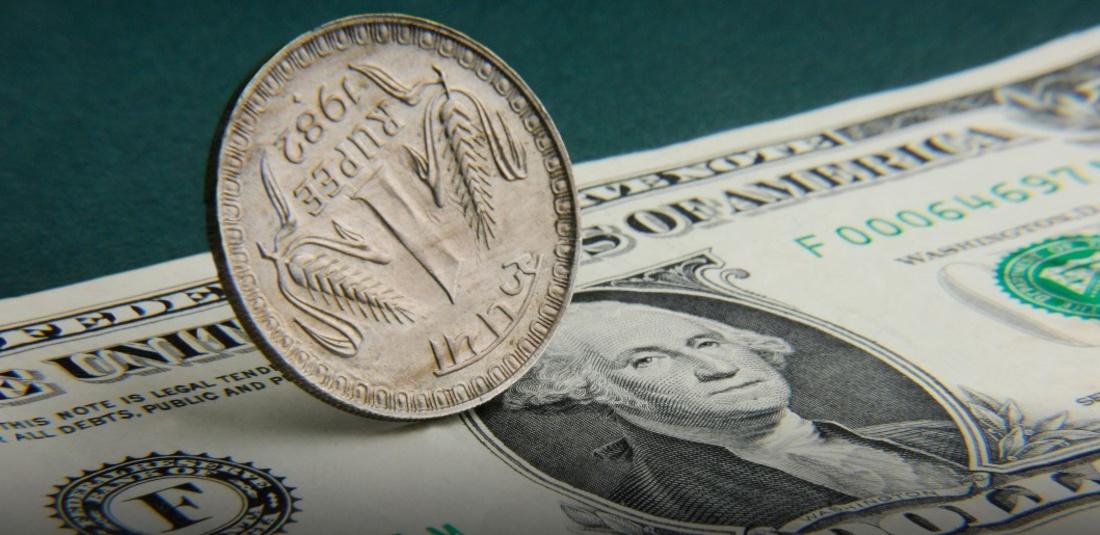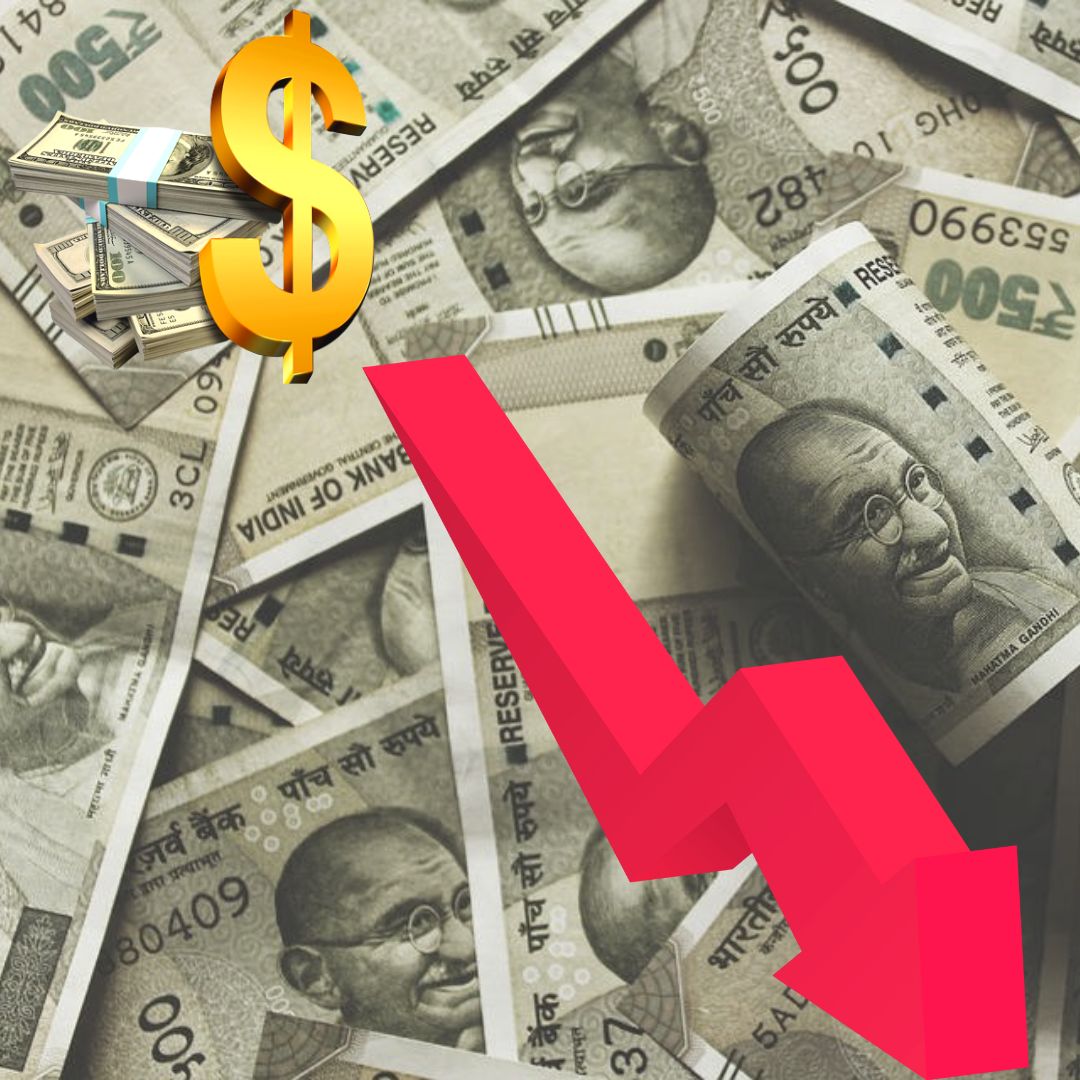The real reason : Why Is the Rupee Declining Against the Dollar, and What Is the Future Course?

The real reason : Why Is the Rupee Declining Against the Dollar, and What Is the Future Course?
Since the beginning of the year, the Indian rupee has been falling, partly because of supply chains being damaged by the Russia-Ukraine conflict, global economic difficulties made worse by the Covid epidemic, inflation, rising crude oil prices, etc.
There are no signs that the rupee will start to gain significantly any time soon; it has been steadily falling. The Indian rupee closed nearly at 79.30 versus the U.S. dollar at the beginning of July, not far from its historically low close of 79.37.
The rupee is sinking, so why?
Supply and demand determine the value of the Indian rupee concerning the U.S. dollar. When there is a higher demand for dollars, the value of the rupee decreases and vice versa.
The impact of the Russian-Ukrainian conflict on supply chains, the Covid pandemic’s escalation of world economic issues, inflation, high crude oil costs, etc., have all contributed to the decline in the value of the Indian rupee since the start of this year.
If a country imports more than it exports, as India does, its Currency will lose value in proportion to the U.S. dollar.
According to experts, the decrease in the rupee in recent months has been principally caused by high crude oil prices, a strong foreign currency, and outflows of foreign capital.
Heavy outflows of foreign capital from domestic markets have occurred is a result of foreign institutional investors (F.I.I.s) selling shares worth more than $30 billion this year. The sell-off of $11.8 billion that was recorded during the global financial crisis in 2008 is a far cry from this.
As money departs India, the rupee loses value, which affects the dollar-rupee exchange rate.
This depreciation has a considerable negative impact on already high import prices for raw materials and petroleum. This, in turn, drives up import inflation and production costs in addition to driving up retail inflation.
Since the U.S. Federal Reserve recently raised interest rates, the return on dollar assets has risen relative to other emerging countries like India. Furthermore, there are concerns that the US Federal Reserve may raise interest rates more quickly, which would be bad for the rupee.
Finally, the backdrop of high inflation, the Covid controversy, monetary tightening by important central banks, and supply chain disruptions brought on by the Russia-Ukraine war have slowed down global economic activity, resulting in the rupee’s massive depreciation against the dollar.
Then, what can be done to halt the alarming downward trend of the rupee?
The government proposed many measures, including higher taxes on the export of gasoline, diesel, and A.T.F., that are expected to restrict foreign trade and halt the depreciation of the rupee. Gold import taxes were increased from 7.5 percent to 12.5 percent.
The Reserve Bank of India is expected to sell dollars in the spot, futures, and other derivatives markets in order to support the rupee. It is probable to raise policy rates even further as part of a process that is expected to lure international investors into debt assets.
But will that be enough?

“If the new global energy order necessitates protracted difficulties in the oil market, India will need to respond much more aggressively in the meantime, with more exports and fewer imports. If not, it is improbable that the R.B.I.’s currency reserves would once more drop to 15% of G.D.P. in the coming years (a formula for external instability, as seen during the 2013 “taper tantrum”).
The ideal course of action is to let the INR progressively decline while allowing the CAD to grow. Emkay Global Financial Services’ research note states that being a result, “we think the R.B.I. may finally leave the currency rate to adjust to new conditions, albeit orderly, allowing it to operate like a natural macro stabilizer to policy reaction functions.”
Analysts agree that India must make conscious efforts to lower imports and increase exports, notwithstanding the possibility that a simple answer is not available.
The government may, in the future, actively promote the use of native products in order to decrease imports and support the rupee.
It is feasible to increase the push for electric vehicles in order to lessen the reliance on crude oil imports.
What does the rupee falling to a low of 80 against the U.S. dollar means for you
Against the U.S. dollar, the Indian rupee hit a record low of 80.05. Here are some effects of the depreciation of the rupee on you, like more expensive vacations and cell phones.
According to N.D.T.V., there is concern that the decline could be steeper since the odds of a free fall after a break in a crucial psychological rate increase.
In response to a question regarding the value of the local Currency on Monday, Finance Minister Nirmala Sitharaman stated in the Lok Sabha that the Indian rupee had fallen by nearly 25% since December 31, 2014.
We investigate and decode the causes of the rupee’s decline and what it implies for the average person without becoming too technical.
What does converting rupees to dollars mean?
The phrase “the rupee has plummeted to a low of 80 dollars” effectively indicates that Rs 80 are required to purchase one dollar.
This is important when purchasing other goods and services in addition to American ones (say crude oil).
Causes of the declining rupee
India’s Currency has lost value when measured against the U.S. dollar, as have the majority of other currencies. In relation to the dollar, the rupee was worth 63.33 on December 30, 2014. On July 11, the price decreased once again to 79.41.
This reduction can be attributed to a number of factors, including inflation, lengthy COVID-19 lockdowns in China, efforts by the main central banks to tighten monetary policy, and supply chain issues brought on by the Russia-Ukraine conflict.
The withdrawal of foreign portfolio capital is another significant factor in the decline in the value of the Indian rupee. Many foreign investors have given up on the Indian markets since U.S. interest rates are rising far more swiftly than those in India.
By 2022–2023, international portfolio investors had already withdrawn over $14 billion from Indian stock markets.
All things considered, the rupee has depreciated against the dollar.

The Indian rupee has been negatively impacted by the F.I.I.s withdrawing money from the equity market, rising crude prices, the worsening trade balance, and the dollar gaining, analysts at Emkay Wealth Management told India Today.
What does this entail for the common person?
The rupee’s fall has a greater impact on importers because they must spend more money to buy the same amount.
Since India imports, more than 85% of the oil and 50% of the gas it uses, the oil and gas industry will be the one that suffers the most.
This implies that the price of oil will rise, which will then trickle down to a variety of goods.Purchasing cars will also grow more expensive as 10–20% of the total value of a car’s raw ingredients are imported.
Mobile phones and other electronic gadgets are also going to become more pricey.Flying will cost more as well because fuel is getting more expensive.
The weakening of the rupee may provide a problem for students who desire to study overseas. This is because the fees are now more expensive in terms of dollars and rupees.
Existing or prospective students may see an increase in costs.
The tourism industry may also suffer greatly from the decreasing rupee. Individuals who want to restart their international journey may wind up spending far more than they would have a few days earlier.
One advantage of the weakening rupee is that Indian exports would become more affordable. The sector of information and technology would benefit the most because the majority of its customers pay in U.S. dollars. As the value of the rupee declines, their incomes do as well.
The optimum time to invest in Indian manufacturing and services, according to many financial analysts, is now. Additionally, the Indian tourism industry will benefit from this time period.
What steps are taken?
Prior to this month, the Reserve Bank of India (R.B.I.) further loosened regulations to increase foreign cash inflows. One such measure was to double the amount that may be borrowed via the External Commercial Borrowing (E.C.B.) method.
The demand for the rupee as a means of exchange to buy Indian assets denominated in foreign currencies would rise as there were more foreign investments.
What caused the decline, and what can the Reserve Bank do about it?
Money is withdrawn from the Indian economy by F.P.I.s, and FIIs are the main cause of the Currency’s decline. F.P.I.s withdrew Rs 2.32 trillion over the previous six months.
Since the beginning of 2022, there has been intense sell-off pressure on the rupee. Since the Russia-Ukraine war began on February 20, 2022, the situation has gotten worse.
The rupee was trading at 74.49 versus the dollar on February 21, 2022. It was trading at 79.24 on July 8—6% less than it had been on February 20. The value of the Indian rupee has repeatedly fallen below its all-time low over the past four and a half months. It reached 79.38 per U.S. dollar on July 5, which was the most recent one.
The rupee is declining; why?
The primary cause of the Currency’s depreciation is the withdrawal of funds by foreign portfolio investors from the Indian economy (F.P.I.s). In the past six months, F.P.I.s have removed Rs 2.32 trillion from the economy. It was largely caused by central banks raising interest rates to control the spiraling inflation.
The rewards on deposits also rise in response to an increase in interest rates. In order to lodge their funds in banks and other financial institutions, foreign investors typically withdraw their money from riskier investment possibilities.
The rising dollar index is another factor contributing to the rupee’s decline. Other currencies lose value when the index goes up.
The index increased by 11% from February 21, when it was trading at 96.12, and July 8, when it was at 107.08.
The Russia-Ukraine war-related increase in commodity prices is another factor that has contributed to the rupee’s decline in value. Major producers of goods like oil, wheat, and fertilizers are Russia and Ukraine.
Due to the war’s disruption of much of the supply, prices have increased, and India’s import expenditure has skyrocketed.
In layman’s terms, a high import bill causes the rupee to lose value since payments are paid in U.S. dollars, which limits the number of dollars available in the domestic economy.
How does it affect the R.B.I. in any way?
To stop the rupee’s decline, the Reserve Bank of India (R.B.I.) sold dollars on the market. The central bank made its largest ever spot market auction in March 2022, selling $20 billion. The forex reserves have been depleted being a result of this. Forex reserves have decreased by $50 billion to $593.3 billion just in 2022.
Additionally, of India’s $621 billion total external debt, more than $200 billion must be repaid in the coming months. The decline in Foreign Exchange Reserves could make things more difficult to navigate.
What can the R.B.I. do to stop the decline of the rupee?
The R.B.I. has taken a number of actions to halt the rupee’s devaluation.
The restrictions on foreign cash non-resident bank accounts, or F.C.N.R. (B) accounts, known by the term the cash reserve ratio (C.R.R.) and statutory liquidity ratio (S.L.R.), have been eliminated. It has made it possible for N.R.I. deposits to earn higher interest rates.
To improve the supply of rupees, the central bank can purchase the market’s bonds back. This will aid in lowering the dollar’s value. Sucking the liquidity out of the market is another strategy.
The interest rates can be raised to do this. People typically deposit more money in their banks when interest rates are higher, which decreases liquidity. In keeping with this, over the past two months, the R.B.I. has increased the repo rate by 90 basis points.
The ongoing Ukraine crisis and the likelihood that global inflation will remain a concern would probably prolong the rupee’s problems and the R.B.I.’s difficulties.
Here’s how the falling Currency will impact your life

The Indian economy, which was slowly recovering after being hurt by the lockdowns brought on by the Covid-19 outbreak, is concerned by the rupee’s declining value in relation to the dollar.
On the 19th, the rupee fell to an all-time low and crossed the 80 to 1 psychological threshold. In the meantime, recession worries and problems in Europe helped the dollar have its strongest first half in more than a decade. This is worrying news for an economy that has been hurt by the lockdowns brought on by the Covid-19 outbreak but is now slowly recovering.
The Russian-Ukrainian conflict, rising crude oil prices, and tightening financial conditions are the primary causes of the Indian rupee’s decline against the U.S. dollar, the Finance Ministry stated at the Lok Sabha.
It added that other major global currencies, including the British pound, the Japanese yen, and the Euro, have declined more than the Indian rupee, showing that the Indian rupee has strengthened against these currencies over the past 20 years.
According to Asheesh Chanda, founder and C.E.O. of the global wealth advising platform Kristal.AI, this is a hint that investors from around the world prefer the security of U.S. markets to the recession risks associated with the E.U.
“The recession in the E.U. looks probably given the looming threat of Russia shutting off the gas supply in the winter and the E.C.B.’s gradual action to contain inflation. As a result, investors are trading dollars for euros. Additionally, it highlights the value of the USD as the safest Currency in difficult times, according to Chanda.
Chanda further stated that given the predicted continued depreciation of the rupee, this would be a good moment for Indian investors to dollarize their holdings.
The lack of R.B.I. involvement may have an impact on perceptions regarding the weakening of the rupee, according to Jateen Trivedi, VP Research Analyst at L.K.P. Securities. The rupee may continue to weaken until it trades below 79.25 on a short-term basis and moves toward the 80.50–80.75 zone.
The rupee continues to face additional pressure as long as the dollar index is above 105. Additional crude price movement and F.I.I. inflows and outflows would provide rupee movement clues.
The declining value of the rupee is probable to have an immediate impact on spending because of the growing costs of energy, imports, loans, and other expenses. Price rises could potentially speed up inflation.
Importing products will become more expensive when the rupee falls since importers must pay for the goods in dollars. Additionally, the cost of oil imports will rise, directly affecting consumer costs. Component costs will rise in addition to those of imported goods, driving up the cost of commodities like cars and appliances.
Loans will probably have an indirect impact. A weaker rupee raises import expenses, raising product prices and causing inflation. When inflation soars, the R.B.I. steps in to change the repo rate, which is at present 4.90 percent. Now that repo rates are high, lending rates increase in cost.
Since interest rates are raised to stabilize inflation and make borrowing more expensive, it must be noted that repo rates and inflation move in tandem.
Imported luxury cars and auto parts will cost more, indicating that the price of similar goods will rise. Phones and other devices that require imported components will consequently cost more money.
A severe decline in equity markets will result from foreign investors looking to exit Indian equities with the decline of Currency. Investments in stocks and mutual funds will drop being a result.
As students will have to pay more rupees for every dollar, international education will become more expensive. Students should recalculate their budget in light of their travel plans, specially if they are going to the U.S.
Another industry that will be affected is travel, especially now that it is starting to recover from the pandemic. Indian travelers will now need to budget more money for their vacations.
The higher value of the rupee will result in N.R.I.s (non-resident Indians) sending more money home from the U.S.
Since exports will now be more competitive being a result of the rupee’s drop, exporters of goods and services will probably benefit too.




